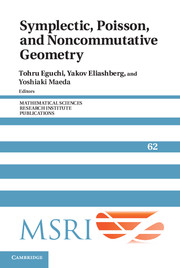Book contents
- Frontmatter
- Contents
- Preface
- Flexible Weinstein manifolds
- The Hirzebruch–Riemann–Roch Theorem in true genus-0 quantum K-theory
- On some deformations of Fukaya categories
- Morphisms of CohFT algebras and quantization of the Kirwan map
- Deformation of expressions for elements of an algebra
- Microlocal theory of sheaves in symplectic topology
- Algebra + homotopy = operad
Preface
Published online by Cambridge University Press: 25 June 2025
- Frontmatter
- Contents
- Preface
- Flexible Weinstein manifolds
- The Hirzebruch–Riemann–Roch Theorem in true genus-0 quantum K-theory
- On some deformations of Fukaya categories
- Morphisms of CohFT algebras and quantization of the Kirwan map
- Deformation of expressions for elements of an algebra
- Microlocal theory of sheaves in symplectic topology
- Algebra + homotopy = operad
Summary
Symplectic geometry has its origin in physics, particularly as a mathematical framework for Hamiltonian mechanics, but it has undergone a remarkable development in the past thirty years as an independent subject in mathematics. Through the work of many outstanding mathematicians, symplectic geometry and its offspring, symplectic topology, have become very active research areas. There are now many applications of symplectic methods back to mathematical physics; for example, Floer theory has contributed new insights to quantum field theory. In a related direction, noncommutative geometry has developed an alternative mathematical quantization scheme, based on a geometric approach to operator algebras. Finally, deformation quantization, a blend of symplectic methods and noncommutative geometry, approaches quantum mechanics from a more algebraic viewpoint, as it addresses quantization as a deformation of Poisson structures. Thus, symplectic geometry and noncommutative geometry offer unique but related perspectives on quantum theory, and with deformation quantization they have led to many fruitful connections between mathematics and physics.
Two research programs, the 2009–2010 MSRI (Mathematical Sciences Research Institute at Berkeley) thematic year on Symplectic and Contact Geometry and Topology and the 2010 RIMS (Research Institute of Mathematical Sciences at Kyoto University) thematic year on Perspectives in Deformation Quantization and Noncommutative Geometry, held joint workshops at MSRI in May 2010.
The conference on Symplectic and Poisson Geometry in Interaction with Analysis, Algebra and Topology was held at MSRI on May 4–7, 2010. It coincided with the first anniversary of Professor Alan Weinstein's retirement from UC Berkeley and was organized jointly with the UC Berkeley Mathematics Department.
Information
- Type
- Chapter
- Information
- Symplectic, Poisson, and Noncommutative Geometry , pp. ix - xiiPublisher: Cambridge University PressPrint publication year: 2014
